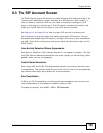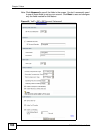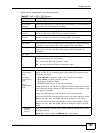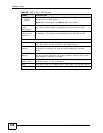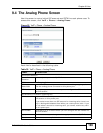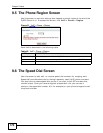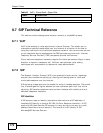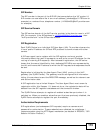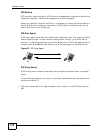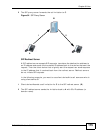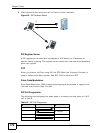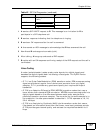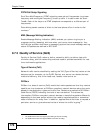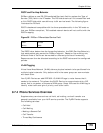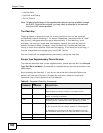
Chapter 9 Voice
P-2612HNU-Fx User’s Guide
173
SIP Number
The SIP number is the part of the SIP URI that comes before the “@” symbol. A
SIP number can use letters like in an e-mail address (johndoe@your-ITSP.com for
example) or numbers like a telephone number (1122334455@VoIP-provider.com
for example).
SIP Service Domain
The SIP service domain of the VoIP service provider is the domain name in a SIP
URI. For example, if the SIP address is 1122334455@VoIP-provider.com
, then
“VoIP-provider.com” is the SIP service domain.
SIP Registration
Each ZyXEL Device is an individual SIP User Agent (UA). To provide voice service,
it has a public IP address for SIP and RTP protocols to communicate with other
servers.
A SIP user agent has to register with the SIP registrar and must provide
information about the users it represents, as well as its current IP address (for the
routing of incoming SIP requests). After successful registration, the SIP server
knows that the users (identified by their dedicated SIP URIs) are represented by
the UA, and knows the IP address to which the SIP requests and responses should
be sent.
Registration is initiated by the User Agent Client (UAC) running in the VoIP
gateway (the ZyXEL Device). The gateway must be configured with information
letting it know where to send the REGISTER message, as well as the relevant user
and authorization data.
A SIP registration has a limited lifespan. The User Agent Client must renew its
registration within this lifespan. If it does not do so, the registration data will be
deleted from the SIP registrar's database and the connection broken.
The ZyXEL Device attempts to register all enabled subscriber ports when it is
switched on. When you enable a subscriber port that was previously disabled, the
ZyXEL Device attempts to register the port immediately.
Authorization Requirements
SIP registrations (and subsequent SIP requests) require a username and
password for authorization. These credentials are validated via a challenge /
response system using the HTTP digest mechanism (as detailed in RFC3261, "SIP:
Session Initiation Protocol").



